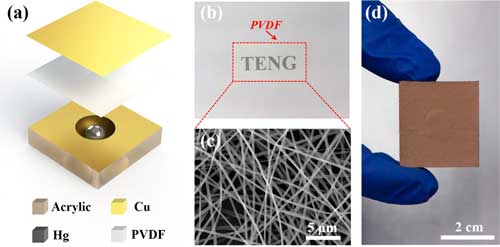| Posted: Jul 08, 2017 | |
Nanogenerator-powered acceleration sensor(Nanowerk News) In new work just published in ACS Nano ("Self-Powered Acceleration Sensor Based on Liquid Metal Triboelectric Nanogenerator for Vibration Monitoring"), researchers have demonstrated a self-powered acceleration sensor based on liquid metal triboelectric nanogenerator (TENG), which was composed of an inner liquid metal droplet (mercury) and an outer acrylic shell. |
|
 |
|
| Structural design of the self-powered acceleration sensor. (a) Schematic diagram of the self-powered acceleration sensor for vibration monitoring. (b) Photograph of the nn-PVDF film composed of nanofibers. (c) SEM image of PVDF nanofibers. (d) Photograph of the fully assembled acceleration sensor. (© ACS) | |
| The device is capable of vibration measurement and analysis in real time. | |
| The team, led by Prof. Zhong Lin Wang at Georgia Tech, utilized an electrospinning method to fabricate the nanofiber-networked polyvinylidene fluoride (PVDF) film, which was beneficial to enhance the output of TENG. | |
| To prove the capability of the liquid metal TENG as an acceleration sensor for vibration measurement and analysis, four sets of practical applications were demonstrated: | |
|
|
|
| The researchers systematically investigated the relationship between the electric output properties and the vibration acceleration. The output voltage and current exhibit a good linear relationship with the external acceleration. | |
| The acceleration sensor shows good performance with the detection range from 0 to 60 m/s2 and sensitivity of 0.26 V·s/m2. | |
| The liquid metal mercury drop could significantly enhance the stability and durability of the acceleration sensor. The output voltage and current show negligible drops after nearly 200,000 cycles. | |
| Furthermore, a high-speed camera with a frame rate of 4000 Hz was employed to dynamically monitor the working process of the acceleration sensor. | |
| The acceleration sensor was very sensitive to small ambient vibrations, such as machine vibration and table vibration. | |
| "This work not only demonstrates a self-powered acceleration sensor with high sensitivity and wide detection range but also expands TENG’s application in self-powered sensing systems," the authors conclude their article. |
 By
Michael
Berger
– Michael is author of three books by the Royal Society of Chemistry:
Nano-Society: Pushing the Boundaries of Technology,
Nanotechnology: The Future is Tiny, and
Nanoengineering: The Skills and Tools Making Technology Invisible
Copyright ©
Nanowerk LLC
By
Michael
Berger
– Michael is author of three books by the Royal Society of Chemistry:
Nano-Society: Pushing the Boundaries of Technology,
Nanotechnology: The Future is Tiny, and
Nanoengineering: The Skills and Tools Making Technology Invisible
Copyright ©
Nanowerk LLC
|
|
|
Subscribe to a free copy of one of our daily Nanowerk Newsletter Email Digests with a compilation of all of the day's news. |
